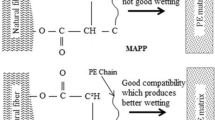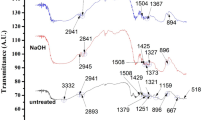Abstract
The study of natural fiber composite in the field of materials has indeed sparked interest among many due to its essential biodegradability feature. As such, pineapple leaf fiber (PALF) is not only biodegradable, but also environmental friendly, as opposed to synthetic fiber. Hence, this paper investigates the effect of fiber loading, as well as the inclusion of maleic anhydride polyethylene (MAPE) to the mechanical properties of PALF reinforced polylactic acid composites. Therefore, untreated PALF with 0, 5, 10, and 15% of weight content ratio, as well as PALF at 10% weight ratio treated with 2, 4, and 6% of MAPE, had been prepared via roll mill mixing at 190 °C and followed by hot compression molding to prepare the specimen sheets. The results obtained from this study revealed that the tensile strength (TS) and the Young’s modulus were at their highest levels for untreated 10% PALF, while the impact and the flexure properties displayed a decrease as the content of fiber increased. Other than that, the inclusion of MAPE indicated that the tensile properties exhibited lower value compared to that of untreated. However, the flexural and the impact properties of composites increased with the presence of MAPE. As a conclusion, the study demonstrates that the mechanical properties depended on two major factors; (1) fiber loading, and (2) the compatibility between matrix polymer and fiber.

















Similar content being viewed by others
Abbreviations
- ASTM:
-
American Society for testing and materials
- MAPE:
-
Maleic anhydride polyethylene
- PALF:
-
Pineapple leaf fibre
- TS:
-
Tensile strength
- PP:
-
Polypropylene
- PE:
-
Polyethylene
References
Singha, A., & Thakur, V. K. (2008). Mechanical properties of natural fibre reinforced polymer composites. Bulletin of Materials Science, 31(5), 791–799.
Jawaid, M., & Abdul Khalil, H. P. S. (2011). Cellulosic/synthetic fibre reinforced polymer hybrid composites: a review. Carbohydrate Polymers, 86(1), 1–18.
Rashid, B., Leman, Z., Jawaid, M., et al. (2016). The mechanical performance of sugar palm fibres (ijuk) reinforced phenolic composites. International Journal of Precision Engineering and Manufacturing, 17(8), 1001–1008.
Lee, M. S., Seo, H. Y., & Kang, C. G. (2016). Comparative study on mechanical properties of CR340/CFRP composites through three point bending test by using theoretical and experimental methods. International Journal of Precision Engineering and Manufacturing-Green Technology, 3(4), 359–365.
Yun, I. S., Hwang, S. W., Shim, J. K., et al. (2016). A study on the thermal and mechanical properties of poly (butylene succinate)/thermoplastic starch binary blends. International Journal of Precision Engineering and Manufacturing-Green Technology, 3(3), 289–296.
Satyanarayana, K. G., Sukumaran, K., Mukherjeem, R. S., et al. (1990). Natural fibre-polymer composites. Cement and Concrete composites, 12, 117–136.
Mohammed, L., Ansari, M. N., Pua, G., Jawaid, M., Islam, M.S., (2015). A review on natural fiber reinforced polymer composite and its applications. International Journal of Polymer Science, 2015, 1–15.
Dicker, M. P., Duckworth, P. F., Baker, A. B., et al. (2014). Green composites: A review of material attributes and complementary applications. Composites part A: applied science and manufacturing, 56, 280–289.
Davoodi, M., Sapuan, S., Ahmad, D., et al. (2010). Mechanical properties of hybrid kenaf/glass reinforced epoxy composite for passenger car bumper beam. Materials and Design, 31(10), 4927–4932.
Mohanty, A., Misra, M., & Hinrichsen, G. (2000). Biofibers, biodegradable polymers and biocomposites: an overview. Macromolecular Materials and Engineering, 276(1), 1–24.
Bledzki, A. K., Faruk, O., & Sperber, V. E. (2006). Cars from bio-fibres. Macromolecular Materials and Engineering, 291(5), 449–457.
Suddell, B. C., & Evans, W. J. (2005). Natural fiber composites in automotive applications, natural fibres, biopolymers and biocomposites (Vol. 37). Boca Raton: CRC.
Cicala, G., Cristaldi, G., Recca, G., et al. (2009). Properties and performances of various hybrid glass/natural fibre composites for curved pipes. Materials and Design, 30(7), 2538–2542.
Asim, M., Abdan, K., Jawaid, M., Nasir, M., Dashtizadeh, Z., Ishak, M., et al. (2015). A review on pineapple leaves fibre and its composites. International Journal of Polymer Science, 2015, 1–16.
Mukherjee, T., & Kao, N. (2011). PLA based biopolymer reinforced with natural fibre: a review. Journal of Polymers and the Environment, 19(3), 714–725.
Bongarde, U. S., & Shinde, V. D. (2014). Review on natural fiber reinforcement polymer composites. International Journal of Engineering Science and Innovative Technology (IJESIT), 3(2), 431–436.
Ku, H., Wang, H., Pattarachaiyakoop, N., et al. (2011). A review on the tensile properties of natural fiber reinforced polymer composites. Composites Part B: Engineering, 42(4), 856–873.
Kim, J.-H., Shim, B. S., Kim, H. S., et al. (2015). Review of nanocellulose for sustainable future materials. International Journal of Precision Engineering and Manufacturing-Green Technology, 2(2), 197–213.
Hempel, F., Bozarth, A. S., Lindenkamp, N., et al. (2011). Microalgae as bioreactors for bioplastic production”. Microbial Cell Factories, 10(1), 81.
Rochman, C. M., Browne, M. A., Halpern, B. S., et al. (2013). Policy: classify plastic waste as hazardous. Nature, 494(7436), 169–171.
Okada, M. (2002). Chemical syntheses of biodegradable polymers. Progress in Polymer Science, 27(1), 87–133.
Kengkhetkit, N., & Amornsakchai, T. (2012). Utilisation of pineapple leaf waste for plastic reinforcement : 1. A novel extraction method for short pineapple leaf fiber. Industrial Crops and Products, 40, 55–61.
Yusof, Y., Yahya, S. A., & Adam, A. (2015). Novel technology for sustainable pineapple leaf fibers productions. Procedia CIRP, 26, 756–760.
Neto, A. R. S., Araujo, M. A., Souza, F. V., et al. (2013). Characterization and comparative evaluation of thermal, structural, chemical, mechanical and morphological properties of six pineapple leaf fiber varieties for use in composites. Industrial Crops and Products, 43, 529–537.
Graupner, N., Herrmann, A. S., & Müssig, J. (2009). Natural and man-made cellulose fibre-reinforced poly(lactic acid) (PLA) composites: an overview about mechanical characteristics and application areas. Composites Part A: Applied Science and Manufacturing, 40(6–7), 810–821.
Orue, A., Jauregi, A., Peña-Rodriguez, C., et al. (2015). The effect of surface modifications on sisal fiber properties and sisal/poly (lactic acid) interface adhesion. Composites Part B: Engineering, 73, 132–138.
Paglicawan, M. A., Kim, B. S., Basilia, B. A., et al. (2014). Plasma-treated abaca fabric/unsaturated polyester composite fabricated by vacuum-assisted resin transfer molding. International Journal of Precision Engineering and Manufacturing-Green Technology, 1(3), 241–246.
Taj, S., Munawar, M. A., & Khan, S. (2007). Natural fiber-reinforced polymer composites. Proceedings-Pakistan Academy of Sciences, 44(2), 129.
Li, X., Tabil, L. G., & Panigrahi, S. (2007). Chemical treatments of natural fiber for use in natural fiber-reinforced composites: a review. Journal of Polymers and the Environment, 15(1), 25–33.
Alvarez, V. A., Ruscekaite, R. A., & Vazquez, A. (2003). Mechanical properties and water absorption behavior of composites made from a biodegradable matrix and alkaline-treated sisal fibers. Journal of Composite Materials, 37(17), 1575–1588.
Ganster, J., & Fink, H.-P. (2006). Novel cellulose fibre reinforced thermoplastic materials. Cellulose, 13(3), 271–280.
Oksman, K., Skrifvars, M., & Selin, J.-F. (2003). Natural fibres as reinforcement in polylactic acid (PLA) composites. Composites Science and Technology, 63(9), 1317–1324.
García, M., Garmendia, I., & García, J. (2008). Influence of natural fiber type in eco-composites. Journal of Applied Polymer Science, 107(5), 2994–3004.
Jia, W., Gong, R. H., & Hogg, P. J. (2014). Poly (lactic acid) fibre reinforced biodegradable composites”. Composites Part B: Engineering, 62, 104–112.
Siregar, J. P., Salit, M. S., Rahman, M. Z. A., et al. (2011). Thermogravimetric analysis (TGA) and differential scanning calometric (DSC) analysis of pineapple leaf fibre (PALF) reinforced high impact polystyrene (HIPS) composites. Pertanika Journal of Science & Technology, 19(1), 161–170.
Siregar, J., Sapuan, S., Rahman, M., et al. (2012). Effects of alkali treatments on the tensile properties of pineapple leaf fibre reinforced high impact polystyrene composites. Pertanika Journal of Science & Technology, 20(2), 409–414.
Nampoothiri, K. M., Nair, N. R., & John, R. P. (2010). An overview of the recent developments in polylactide (PLA) research. Bioresource Technology, 101(22), 8493–8501.
Prachayawarakorn, J., Sangnitidej, P., & Boonpasith, P. (2010). Properties of thermoplastic rice starch composites reinforced by cotton fiber or low-density polyethylene. Carbohydrate Polymers, 81(2), 425–433.
Khalid, M., Ali, S., Abdullah, L., et al. (2006). Effect of MAPP as coupling agent on the mechanical properties of palm fiber empty fruit bunch and cellulose polypropylene biocomposites. International Journal of Engineering and Technology, 3(1), 79–84.
Kalapakdee, A., & Amornsakchai, T. (2014). Mechanical properties of preferentially aligned short pineapple leaf fiber reinforced thermoplastic elastomer: Effects of fiber content and matrix orientation. Polymer Testing, 37, 36–44.
Murty, V., & De, S. (1982). Short jute fiber reinforced rubber composites. Rubber Chemistry and Technology, 55(2), 287–308.
Coran, A., Boustany, K., & Hamed, P. (1974). Short-fiber-rubber composites: The properties of oriented cellulose-fiber-elastomer composites. Rubber Chemistry and Technology, 47(2), 396–410.
Lu, J. Z., Wu, Q., & Negulescu, I. I. (2005). Wood-fiber/high-density-polyethylene composites: coupling agent performance. Journal of Applied Polymer Science, 96(1), 93–102.
Mohanty, S., Verma, S. K., & Nayak, S. K. (2006). Dynamic mechanical and thermal properties of MAPE treated jute/HDPE composites. Composites Science and Technology, 66(3), 538–547.
Gassan, J., & Bledzki, A. K. (1997). The influence of fiber-surface treatment on the mechanical properties of jute-polypropylene composites. Composites Part A: Applied Science and Manufacturing, 28(12), 1001–1005.
Rana, A., Mandal, A., Mitra, B., et al. (1998). Short jute fiber-reinforced polypropylene composites: effect of compatibilizer. Journal of Applied Polymer Science, 69(2), 329–338.
Yang, H.-S., Wolcott, M. P., Kim, H.-S., et al. (2007). Effect of different compatibilizing agents on the mechanical properties of lignocellulosic material filled polyethylene bio-composites. Composite Structures, 79(3), 369–375.
Siregar, J. P., Sapuan, S., Rahman, M., et al. (2010). The effect of alkali treatment on the mechanical properties of short pineapple leaf fibre (PALF) reinforced high impact polystyrene (HIPS) composites. Journal of Food, Agriculture and Environment, 8(2), 1103–1108.
Hashemi, W. F. S. A. J. (2011). Foundation of materials science and engineering (5th ed.). Singapore: McGraw-Hill Companies Inc.
Threepopnatkul, P., Kaerkitcha, N., & Athipongarporn, N. (2009). Effect of surface treatment on performance of pineapple leaf fiber–polycarbonate composites. Composites Part B: Engineering, 40(7), 628–632.
Panyasart, K., Chaiyut, N., Amornsakchai, T., et al. (2014). Effect of surface treatment on the properties of pineapple leaf fibers reinforced polyamide 6 composites. Energy Procedia, 56, 406–413.
Sukumaran, K., Satyanarayana, K., Pillai, S., et al. (2001). Structure, physical and mechanical properties of plant fibers of Kerala. Metals Mater Process, 13(2/4), 121–136.
Karmarkar, A., Chauhan, S., Modak, J. M., et al. (2007). Mechanical properties of wood–fiber reinforced polypropylene composites: Effect of a novel compatibilizer with isocyanate functional group. Composites Part A: Applied Science and Manufacturing, 38(2), 227–233.
Yang, H.-S., Kim, H.-J., Son, J., et al. (2004). Rice-husk flour filled polypropylene composites; mechanical and morphological study. Composite Structures, 63(3), 305–312.
Rana, A. K., Mandal, A., & Bandyopadhyay, S. (2003). Short jute fiber reinforced polypropylene composites: Effect of compatibiliser, impact modifier and fiber loading”. Composites Science and Technology, 63(6), 801–806.
Rowell, R. M. (2007). Challenges in biomass–thermoplastic composites. Journal of Polymers and the Environment, 15(4), 229–235.
Acknowledgements
The authors wish to thank the Malaysian Ministry of Higher Education for funding the research through the Fundamental Research Grant Scheme (FRGS) with grant number RDU 140120. The authors are also obliged to express their gratitude to Universiti Malaysia Pahang for generously providing essential laboratory facilities.
Author information
Authors and Affiliations
Corresponding author
Additional information
Publisher's Note
Springer Nature remains neutral with regard to jurisdictional claims in published maps and institutional affiliations.
Rights and permissions
About this article
Cite this article
Siregar, J.P., Jaafar, J., Cionita, T. et al. The Effect of Maleic Anhydride Polyethylene on Mechanical Properties of Pineapple Leaf Fibre Reinforced Polylactic Acid Composites. Int. J. of Precis. Eng. and Manuf.-Green Tech. 6, 101–112 (2019). https://doi.org/10.1007/s40684-019-00018-3
Received:
Revised:
Accepted:
Published:
Issue Date:
DOI: https://doi.org/10.1007/s40684-019-00018-3




